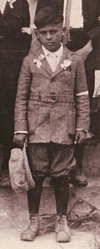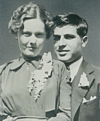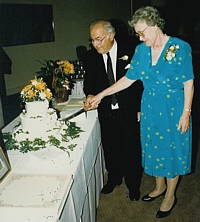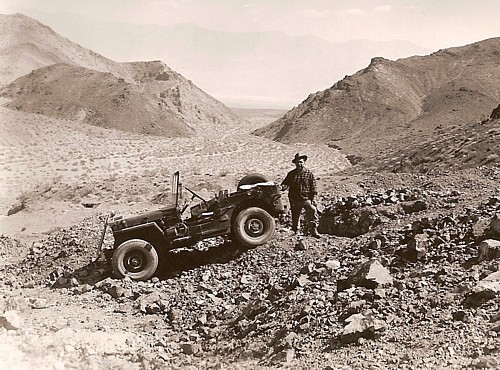|
In 1943, Pete made the move to California,
where he initially worked in a
defense plant. It was at this time that he became interested in starting his own business. With the little money he had saved, he went into
partnership in a display business with Joe Seidman. The display business
included the manufacture of mannequins, display setups for department stores,
and the decorating and manufacturing of display materials. The original shop was
in downtown Los Angeles. Pete continued to work at the defense plant,
moonlighting another full day at the display business. He sent for his family,
and a short time after their arrival in California, they moved into a loft
apartment over the shop. Since the war had made housing impossible to find, the display work took Pete around the country, expanding his business contacts
and know-how. Work was done for the May Company in Los Angeles
(displays and mannequins), the Sahara Hotel in Los Vegas (decorating the
original casino), the city of San Diego (a huge, ice mountain for a Christmas display), and
a litany of others.
They continued to live in the loft apartment several more months, and in September, 1944, they purchased a home
in
Los Angeles. Their daughter, Leslie, was born there in 1949. In 1953, Pete
moved his business (now the P.L. De Luca Company) to new quarters on
Jefferson Blvd. in the Belwin Hills area of Los Angeles. It was there that he
became involved with the molded-fibre die dry process which culminated in the
establishment and building of Western Molded Fibre in Gardena, California. The
company was built primarily for the manufacture of molded fibre fairings for
airborne rocket launchers. The molded fiber material was ideal
for high speed wind resistance while remaining easily frangible for rocket
penetration. The frangible fairing, one of Pete's designs, is still in use today. Western
Molded also made molded fibre tow targets, tote boxes and corn boxes, while
continuing to manufacture mannequins and other display material.
In 1960, Western Molded Fibre merged with Hawley Products Company
of St.
Charles, Illinois, the largest manufacturer of molded fiber products in the
United States. This company manufactured all of the very high quality speaker
cones for sound reproduction at that time. They also produced the shells for
American Tourister Luggage, many automobile heater system components, and a
variety of other items made by the molded fiber process. Pete became Vice-President
of this company while still holding the reigns at Western Molded. While
with that company, he established their introduction into the military field by rejuvenating
a 20MM ammunition separator and designing a molded fiber pallet
for transportation and air drop of material. At Western Molded Fibre,
he developed the production of cork plugs for the five inch 54 and 38 naval rounds,
a product entirely new to himself. It was during this period that Pete
became
interested in the development of the combustible cartridge case. Some work in
the area had been done by the government and Armour Research Institute, but a
feasible economic method of production had not yet been developed.
Using the Western Molded Fibre facilities, Pete developed tooling and procedures
(with some patents under his name) to manufacture the 152MM combustible case and
its associated case, the XM194 Shillelage case. It is interesting to note that
stub base 90MM and 105MM cases, both live and inerts, were also
experimented with at that time. Pete left Hawley Products Company in 1967
and joined with a partner, Norman Dreyfuss, the president of E.F.M.C. Corporation
in Compton, California, a manufacturer of fiberglass gun shields and associated
products. The two men established E.F.M.C. Technical Systems, a new plant which
was built
in Coachella, California to manufacture cartridge cases. The plant was built
with private money and faith built on Pete's known ability, knowledge and
contacts in the field. The plant was built on a barren, plowed-under,
cotton field. Ground was broken
in February 1968, with parts being produced by July of that year. A small production contract was
awarded, and the first article was presented in October. Pete had designed the entire plant from scratch, based on his growing knowledge
of the combustible materials. The plant was laid out to conform with government
quality distance requirements and all other safety aspects of manufacture
known at the time. Nearly all the personnel initially employed were local people, some of
whom helped in the construction of the facility. The technical staff was
minimal, consisting of Pete and two others who had worked for him at Western
Molded Fibre. A chemist, quality control manager and production manager were
later hired.
The original l52MM case was a post-impregnated and re-struck
product, identical to the case being produced at that time by Western Molded Fiber. The case had inherent problems in manufacture and in use as an end
product. As a result, the arsenal which had instigated initial trials awarded a
contract to E..F.M.C. for the production of the XM157E1 case. This case and
the processes developed for its evolved configuration, the M20S, was the basis
for the development of the igniter tubes, mortar increments and many R&D
products . In 1970 E.F.M.C. merged with Heath Techna, a diversified
corporation headquartered in Kent, Washington. This Corporation is now Criton
Corporation. Pete remained with the company as President and
Director of Manufacturing, despite trying to retire on several occasions to his
many other pursuits.
|



